
Aaron Foyer
Vice President, Research and Analytics
Discover if it's a reality or if we're still years away

Aaron Foyer
Vice President, Research and Analytics
On the banks of the Columbia River in Washington, earthworks and construction have started on a new type of power plant by a company called Helion. Cement trucks lay down more than concrete grounds; they are laying the groundwork for what could become a world-changing new industry: fusion power. The facility being built goes by the name Project Orion and is unlike any other fusion project on the planet.
For one, Project Orion is neither a prototype nor a science experiment: it’s the first ever attempt to build a true working commercial fusion power plant. At 50 megawatts in size, it’s much larger than any fusion prototype. And far from a promise that the technology will hopefully work sometime in the future, Scouts honor, Helion Energy signed the world’s first fusion power purchase agreement with Microsoft two years ago to begin delivering electricity by 2028.
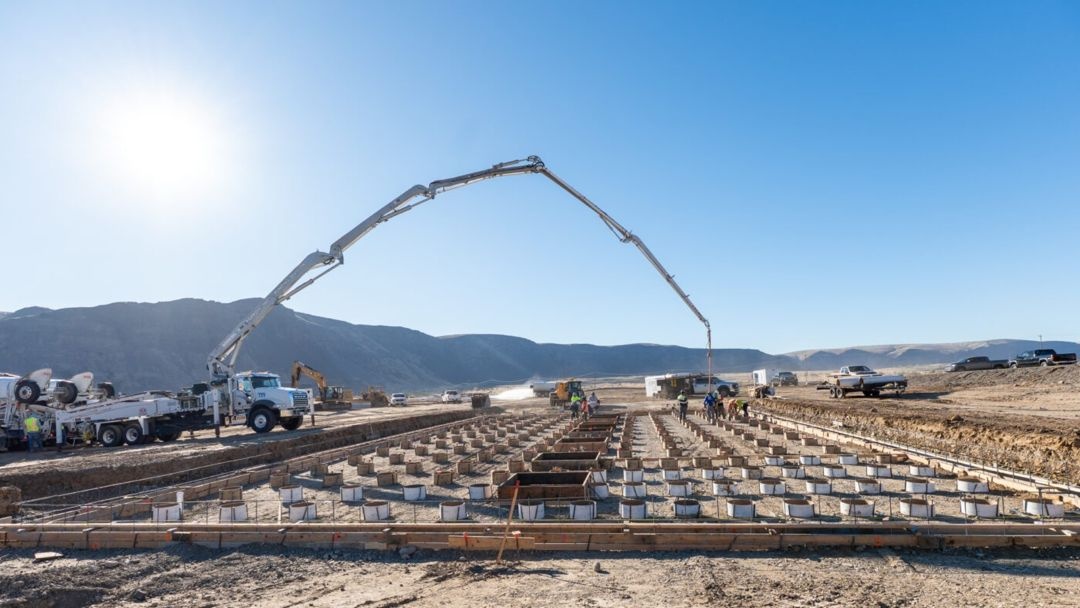
A concrete pump truck lays the foundation for Helion’s Orion project in Malaga, Washington
Helion isn’t alone in delivering world-firsts in the fusion space. Earlier this year, the WEST fusion reactor in France was able to maintain a plasma at 50 million degrees Celsius for more than 22 minutes, a heroic feat. The Wendelstein 7-X reactor across the border in Germany held the coveted “triple product” for more than 30 seconds with its revolutionary stellarator design. And in the 12 months leading up to July, fusion companies raised more than $2.6 billion in funding, much of it from private investors.
Criticality check: This sudden flurry of technological and commercial breakthroughs for the industry has caught many by surprise. For decades, the joke has been that fusion power is 30 years away and always will be.
In 1955, Indian fusion physicist Homi J. Bhabha told the United Nations: “I venture to predict that a method will be found for liberating fusion energy in a controlled manner within the next two decades.” That would imply 1975, which came and went without a peep. While just a decade ago, the European Fusion Development Agreement predicted, in its words “ambitiously,” that fusion would finally deliver electricity in 2050. The finish line just keeps getting pushed.
It’s a lot of mixed messages. So, with Project Orion, all the scientific hype and the many so-called “breakthroughs,” is nuclear fusion any closer to being a reality? Or are we still 30 years away and always will be? Let’s fire up the reactor and find out.
Unlike conventional nuclear power, which generates energy by splitting atoms, the energy from fusion comes from fusing atoms together. This difference may seem trivial, but it’s not.
Stars are the best natural fusion reactors we know of. At the center of the Sun, where fusion takes place, the pressure from gravity is a weighty 250 billion atmospheres, so high that hydrogen atoms are naturally fused together, releasing the energy that powers the Sun.
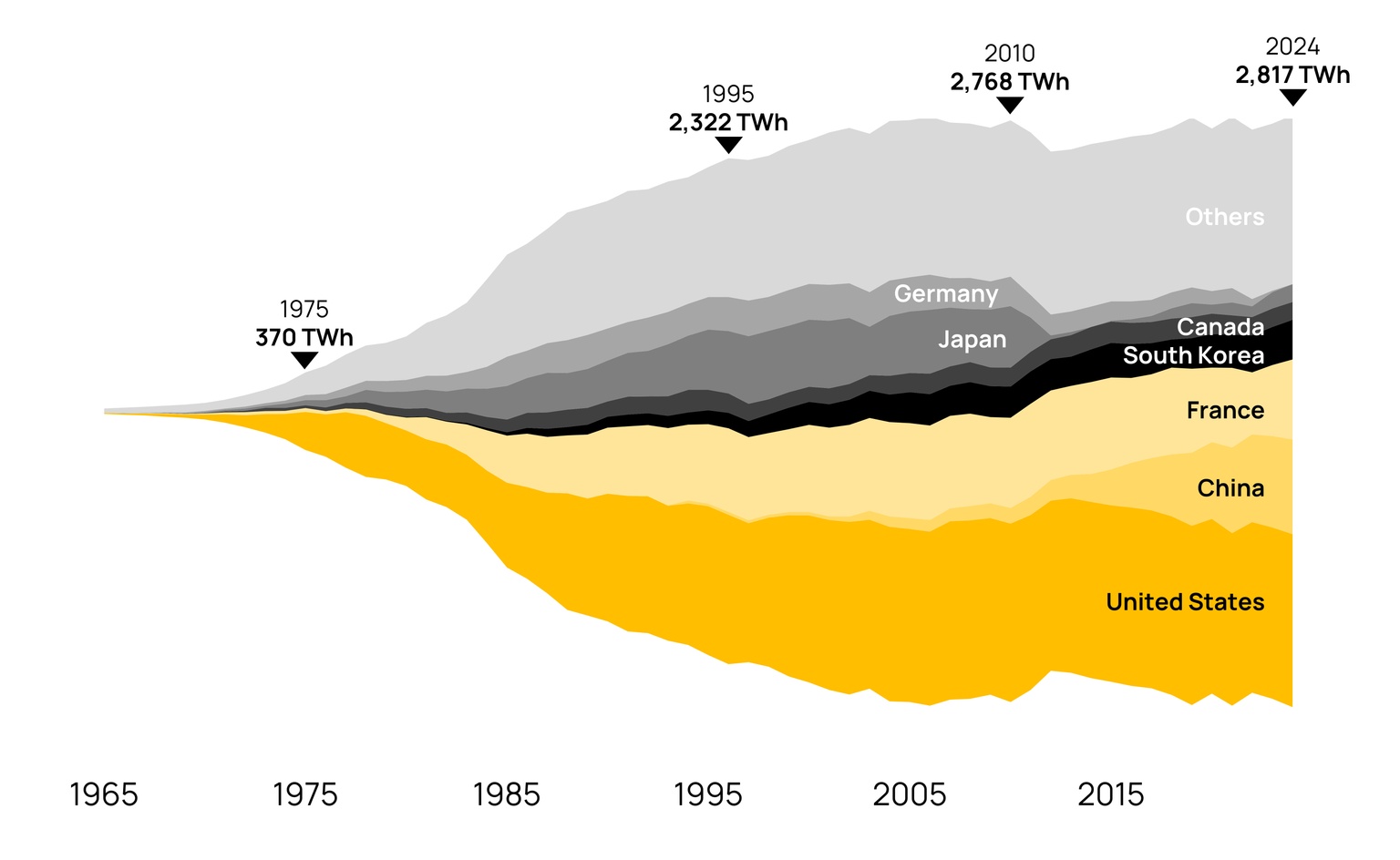
Source: Statistical Review of World Energy (Energy Institute)
Unfortunately for us, without benefitting from the extreme gravity of a star, fusion is much harder to conjure up on Earth. When it was first harnessed by humans, in a thermonuclear weapon test in the Marshall Islands in 1952, a Hiroshima-like fission nuclear bomb was used simply as the detonating device, creating enough heat and pressure to initiate the main fusion reaction. And beyond kickstarting fusion, containing and exploiting the released energy is a challenge of another order of difficulty.
To pull it off, there are two leading reactor designs: magnetic confinement and inertial confinement.
Magnetic confinement: The main goal with these reactors is to turn hydrogen into a plasma hot enough to self-sustain fusion, extract some heat and not vaporize the machine. Like thermal power plants, the captured heat converts water into steam, which turns a generator and produces electricity. Unlike thermal plants, the heat inside can exceed 150 million degrees Celsius, 10 times the temperature at the center of the Sun. Even using exotic materials like tungsten with ultra-high melting points, nothing can survive 150-million-degree plasma. So the technical challenge is to confine the heat and spare the reactor.
Using what might be the most alien or Star Trek-like technology we have on Earth, giant superconducting magnets create powerful magnetic fields that act as an invisible bottle for the plasma, forcing it to spiral around a reactor rather than fly into its walls. Easier said than done: controlling hot plasma is not only the hardest problem to solve in fusion, but one of the most epic engineering challenges in human history and why the technology has always been “30 years away.”
A shortcut, of course, would be a design that didn’t rely on controlling the plasma at all.
Inertial confinement: The leading alternative design is to use lasers to recreate the conditions inside a star. The idea is to put a small amount of hydrogen fuel into a capsule the size of a peppercorn, then use dozens of high-powered lasers fired from many directions simultaneously to blast the fuel inwards at speeds faster than a bullet. The gaseous fuel becomes a white-hot plasma, compresses to 100 times denser than lead and heats up to over 100 million degrees Celsius, sparking the fusion reaction.
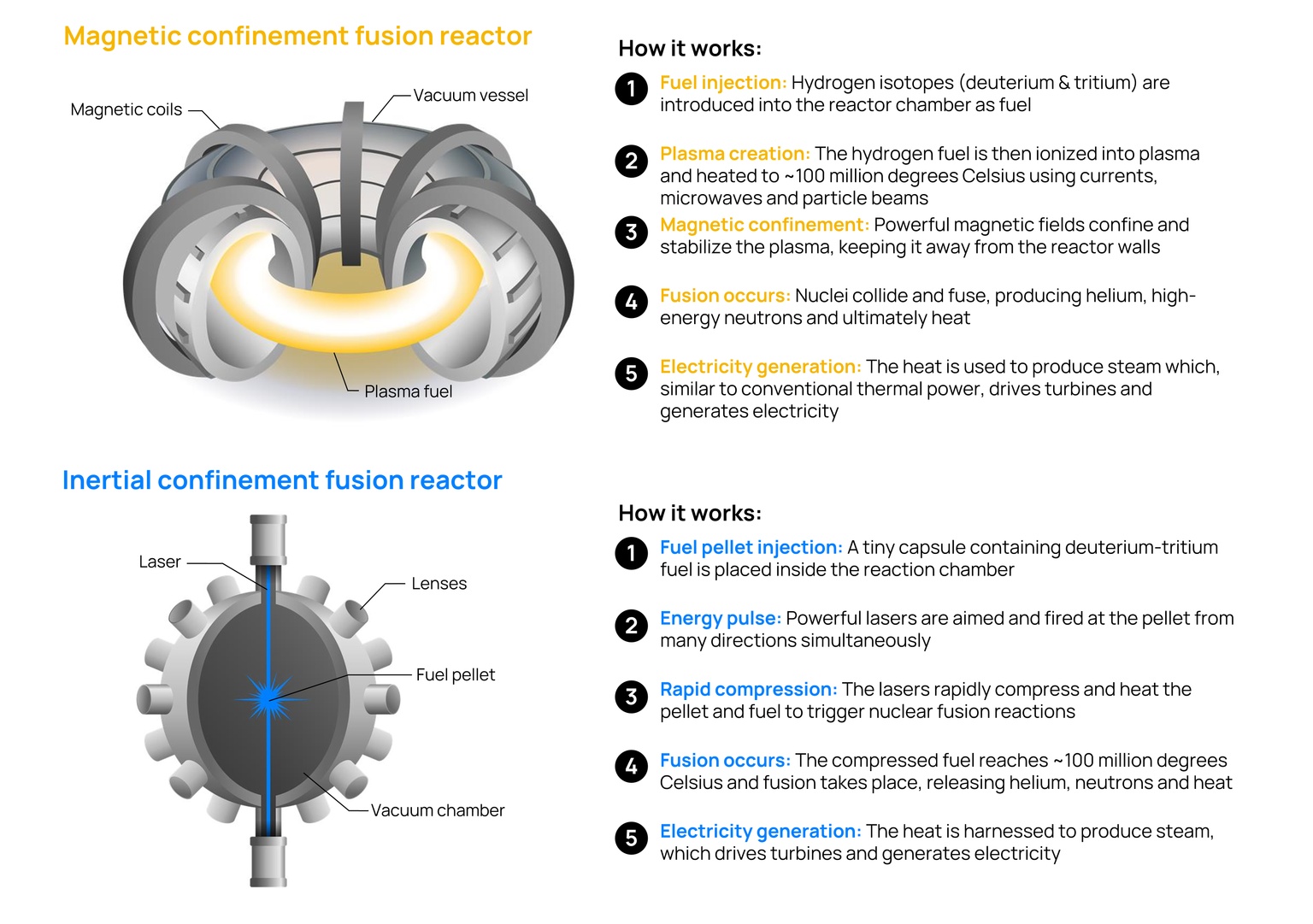
The fusion lasts just a billionth of a second, but its thermonuclear burn produces more than enough energy to capture and use. And since it’s all over faster than a Pete Davidson relationship, there’s little need for huge magnets to protect the reactor from flagrant plasma, because there is no flagrant plasma.
For fusion enthusiasts, there has been plenty to be excited about for scientific breakthroughs.
On the magnetic confinement front, labs around the world have been making big strides, particularly with the ability to control the superheated plasma. Earlier this year, the WEST tokamak reactor in France was able to maintain a plasma for 22 minutes, while a lab in China using its EAST reactor (they’re not all named after their home region) held for 17 minutes. This is in no small part due to the use of artificial intelligence.
AI-based controls are being tested and used to better shape and contain the plasma in real-time, with the giant superconducting magnets being used to manage any unexpected collapses or outbursts. Again, like something straight off the Starship Enterprise.
And beyond plasma control, scientists and engineers have developed better superconducting magnets, stellarator designs and more robust materials, including something called “super steel.”
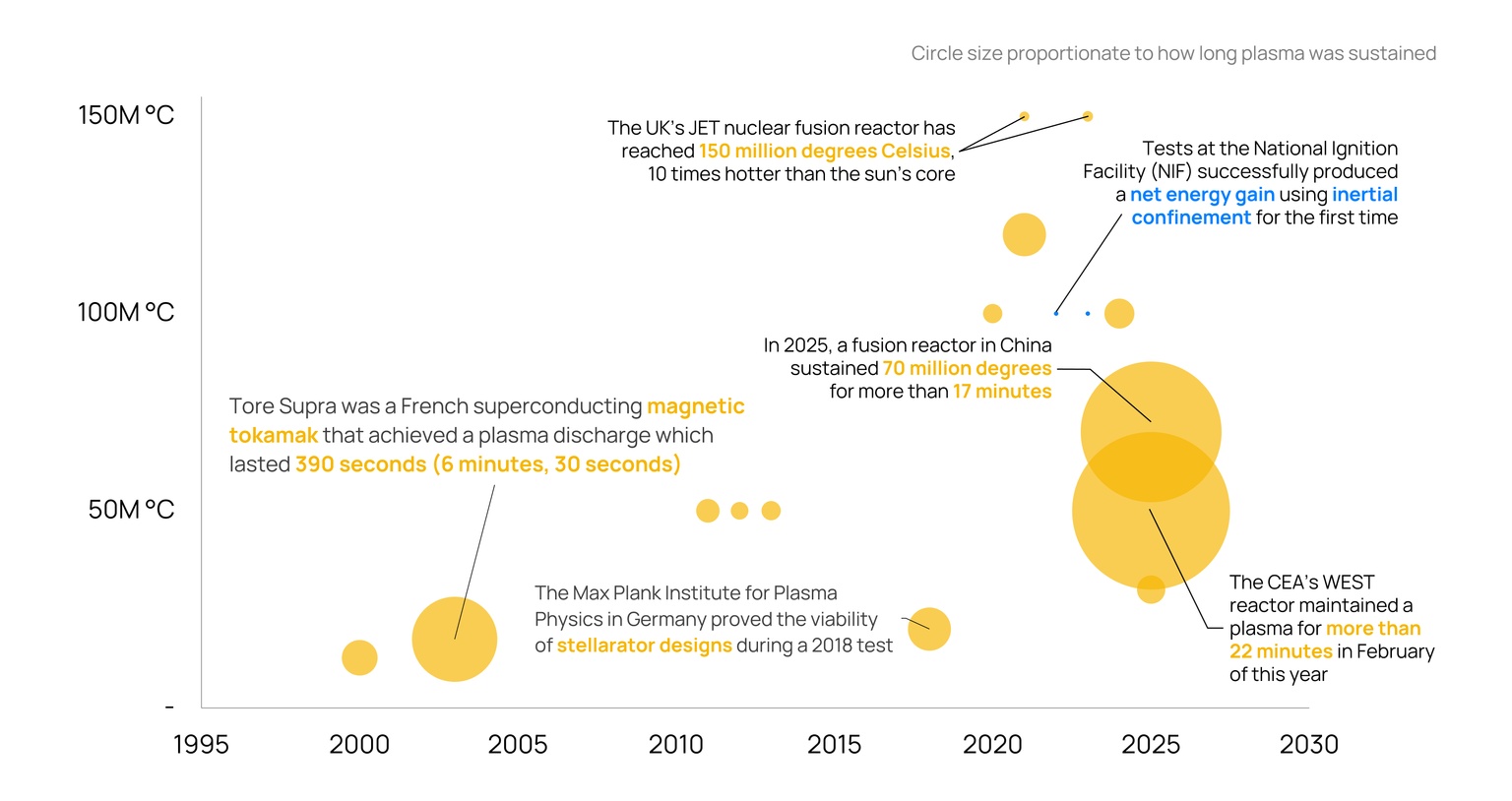
Source: Public disclosures
And labs testing inertial confinement designs have had their own reasons to pop champagne.
In December 2022, in a world first, a fusion reaction in the National Ignition Facility (NIF) lab in California generated more energy than was used to start it. “For the first time on Earth, scientists have confirmed a fusion energy experiment released more power than it takes to initiate, proving the physical basis for fusion energy,” said Andrew Holland, chief of the fusion industry’s trade group, the Fusion Industry Association.
AI is also being used here, to better predict the conditions needed for laser-driven ignition.
Don’t be fooled by the regular drumbeat of “breakthrough” headlines about fusion. There are still some incredible challenges ahead.
More efficient super magnets: For magnetic confinement reactors, while there have been tests going back to the ’90s when more energy was produced from the plasma than was used to ignite it, no design has ever achieved a full net electrical power gain. In layman’s terms, the machine as a whole still uses more energy than it generates. Turns out, those Starship Enterprise superconducting magnetics used to keep the machine from destroying itself consume a lot of power. It’s not expected that any magnetic confinement machine will overcome this hurdle until at least the mid-2030s, when the ITER reactor in southern France is brought online. Even then, ITER aims to produce the coveted net energy gain, but still not electricity. That’s for a future reactor design.
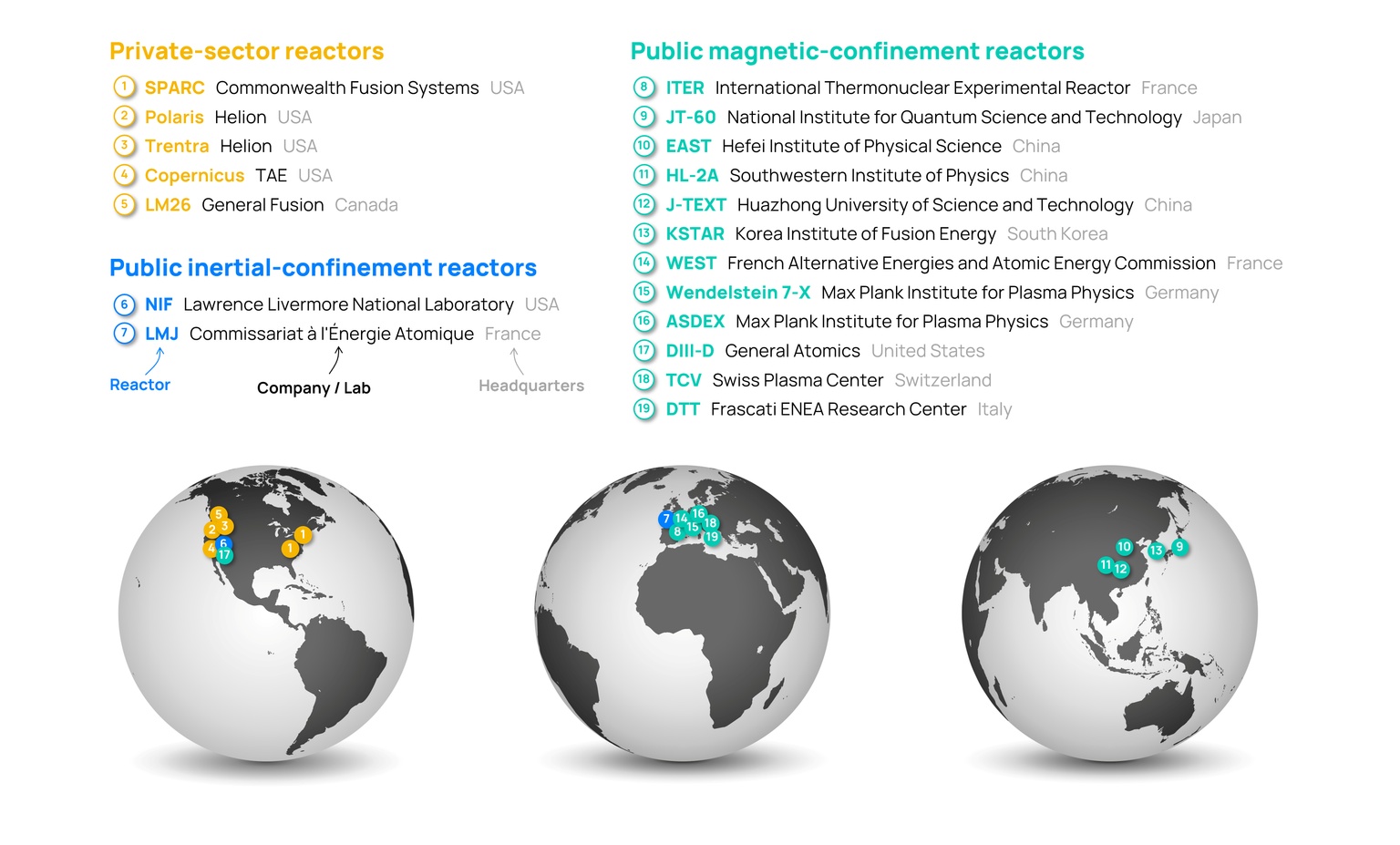
Source: Fusion Industry Association, public disclosures
And materials science is still a long way off from where it needs to be. Any surface that faces the plasma must survive heat comparable to a rocket nozzle, but on a continuous basis. Things like liquid-metal walls are being studied, but no material has proven to last for years under reactor conditions. Not to mention that turning on a single fusion reactor would require roughly 10 kilograms of tritium fuel, when there are just 25 to 30 kilograms combined in all global stocks.
More, cheaper pellets: If magnetic confinement reactors have a tritium shortage problem, it’s doubly so for the inertial confinement reactors, which are much less efficient in converting the rare fuel to energy. And that’s the least of its challenges.
Today, the NIF can successfully shoot one pellet per day with its lasers. A working commercial power plant would need to shoot five to 10 pellets per second. Given pellets currently cost ~$100,000 apiece to manufacture, the fusion industrial complex and supply chains also need advancing.
The system that uses well-coordinated laser shots like an Apex Legend squad to ignite the fusion needs improvement, too. Each laser would have to recharge in just milliseconds to keep the power plant operating. And the state-of-the-art lasers being used at the NIF convert just 0.5% of electricity from the wall into the laser beam, something that needs to improve at least 20x for any inertial confinement design to hope to be profitable.
No matter how you cut it, fusion is still a long way off.
Even the commercial Helion project in Washington is a bit misleading. It uses a completely novel design, operating more like a piston engine with giant magnets for compression. Then, like a judo master, uses the negatives of the other designs into positives that generate electricity. Cool design, but unproven at scale. And the headline-grabbing PPA with Microsoft is more like a pact of solidarity: if Helion’s machine happens to generate net-positive electricity, Microsoft will happily buy it to support the endeavor. Just don’t expect the town of Malaga to be running solely on fusion power anytime soon.
But nuclear is a technology that has already shown it can be developed for a fortune, then rapidly come down the cost curve with innovation and supply chain scale. The cost to produce the first two bombs from the Manhattan project is estimated at $30 billion in today’s dollars, whereas a single fission bomb can now be produced for just $20 million, a drop in cost of 99.9%.
And there are always glimmers of hope. Just last month, the Tennessee Valley Authority, the largest public utility in the US, announced it would build a fusion plant in Oak Ridge, Tennessee, using a stellarator magnetic confinement reactor. Shortly after, the Italian energy firm Eni invested $1 billion into Commonwealth Fusion Systems for a project in Virginia.
Bottom line: Fusion power is still probably 30 years away, but this time, the industry might just be right.
Data-driven insights delivered to your inbox.